by Stephen C. Lougheed
The parrots comprise a large order (Psittaciformes) of birds with a mainly pantropical distribution, although some species do inhabit temperate regions in the Southern Hemisphere as well (e.g. the burrowing parrot, Cyanoliseus patagonus, of southern South America). Number of species reported varies but generally is on the order of 340 to 370 distributed across between 78 and 86 genera (Rowley and Collar 1997). Characteristics of parrots will be familiar to most: robust, curved bill, strong legs with zygodactylous feet (two toes forward, two toes facing backward). Many are brightly-coloured although some, like the sulfur-crested cockatoo (Cacatua galerita) are mostly white, while others, like the flightless Kakapo (Strigops habroptila) of New Zealand, have muted and cryptic plumage patterns to avoid predators.

In my still unfolding peregrinations in Australia I have already seen 10 species of parrot including this lovely northern rosella (photo by Cam Hudson – see his blog – from some distance – but still showing some of the vibrant colours).
My list thus far includes:
- Red tailed black-cockatoo, Calyptorhynchus banksii

Gallah taken just outside Nitmiluk National Park. Click on thumbnail for larger image. - Yellow tailed black-cockatoo, Calyptorhynchus funereus
- Gallah, Eolophus roseicapilla
- Little corella, Cacatua sanguinea
- Sulfur-crested cockatoo, Cacatua galerita
- Rainbow lorikeet, Trichoglossus haematodus
- Red-shoulder parrot, Diopsittaca nobilis
- Eastern rosella, Platycercus eximius (see photo)
- Hooded parrot, Psephotus dissimilis
- Northern rosella, Platycercus venustus
![]() Unfortunately, at least 80 species of parrot are classified as vulnerable or endangered (IUCN 2013) due to a mixture of habitat loss, collection for the pet trade, and persecution because some are considered agricultural pests (Collar 2007) with some already extinct. Indeed, the only psittacid of Eastern North America went extinct in the early 20th Century. The Carolina parakeet (Cacatua galerita) once ranged from southern New York, south to the Gulf of Mexico and as far west as Nebraska (Snyder 2004). The Carolina parakeet was a lovely species, with bright yellow head, orange face, green body and pale bill (see John James Audubon’s rendering here). One can imagine that, before European settlement (and ensuing loss of the Eastern deciduous forest, persecution because it foraged on orchards, and hunting for the millinery trade – nothing like a stuffed parakeet on your hat I guess – see Saikku, 1990), very occasionally one might even have seen a northern vagrant parakeet in Canada.
Unfortunately, at least 80 species of parrot are classified as vulnerable or endangered (IUCN 2013) due to a mixture of habitat loss, collection for the pet trade, and persecution because some are considered agricultural pests (Collar 2007) with some already extinct. Indeed, the only psittacid of Eastern North America went extinct in the early 20th Century. The Carolina parakeet (Cacatua galerita) once ranged from southern New York, south to the Gulf of Mexico and as far west as Nebraska (Snyder 2004). The Carolina parakeet was a lovely species, with bright yellow head, orange face, green body and pale bill (see John James Audubon’s rendering here). One can imagine that, before European settlement (and ensuing loss of the Eastern deciduous forest, persecution because it foraged on orchards, and hunting for the millinery trade – nothing like a stuffed parakeet on your hat I guess – see Saikku, 1990), very occasionally one might even have seen a northern vagrant parakeet in Canada.
References
- Collar, N.J. 2007. Globally threatened parrots: criteria, characteristics and cures. International Zoo Yearbook 37: 21–35.
- IUCN 2013. IUCN Red List of Threatened Species. Version 2013.2. <www.iucnredlist.org>. Downloaded on 22 January 2014.
- Rowley, I. and N.J. Collar. 1997. Order PSITTACIFORMES. In Handbook of the Birds of the World – Volume 4. Sandgrouse to Cuckoos. (J. del Hoyo, A. Elliott, J. Sargatal eds.) Lynx Edicions
- Saikku, M. 1990. The extinction of the Carolina parakeet. Environmental History Review 14: 1-18.
- Snyder, N.F.R. 2004. The Carolina Parakeet: Glimpses of a Vanished Bird Princeton University Press. Princeton, NJ.